石油英语翻译 实践内容
石油专业外文翻译(SPE 121762),英文原文可根据spe号在百度文库收索即可。
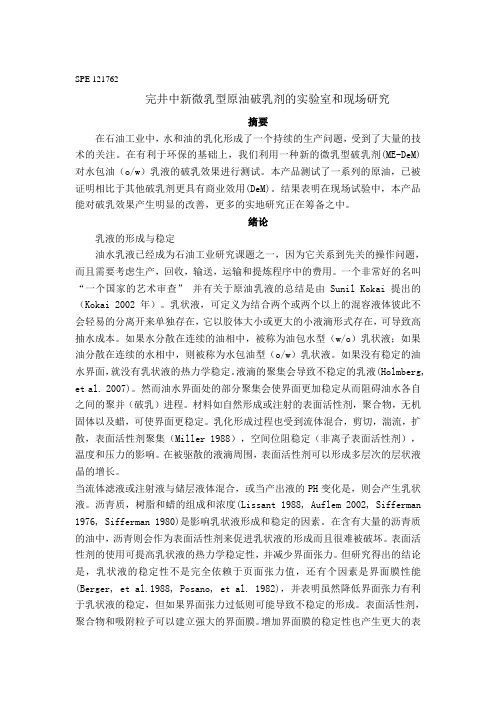
SPE 121762完井中新微乳型原油破乳剂的实验室和现场研究摘要在石油工业中,水和油的乳化形成了一个持续的生产问题,受到了大量的技术的关注。
在有利于环保的基础上,我们利用一种新的微乳型破乳剂(ME-DeM)对水包油(o/w)乳液的破乳效果进行测试。
本产品测试了一系列的原油,已被证明相比于其他破乳剂更具有商业效用(DeM)。
结果表明在现场试验中,本产品能对破乳效果产生明显的改善,更多的实地研究正在筹备之中。
绪论乳液的形成与稳定油水乳液已经成为石油工业研究课题之一,因为它关系到先关的操作问题,而且需要考虑生产,回收,输送,运输和提炼程序中的费用。
一个非常好的名叫“一个国家的艺术审查” 并有关于原油乳液的总结是由Sunil Kokai提出的(Kokai 2002年)。
乳状液,可定义为结合两个或两个以上的混容液体彼此不会轻易的分离开来单独存在,它以胶体大小或更大的小液滴形式存在,可导致高抽水成本。
如果水分散在连续的油相中,被称为油包水型(w/o)乳状液;如果油分散在连续的水相中,则被称为水包油型(o/w)乳状液。
如果没有稳定的油水界面,就没有乳状液的热力学稳定。
液滴的聚集会导致不稳定的乳液(Holmberg, et al. 2007)。
然而油水界面处的部分聚集会使界面更加稳定从而阻碍油水各自之间的聚并(破乳)进程。
材料如自然形成或注射的表面活性剂,聚合物,无机固体以及蜡,可使界面更稳定。
乳化形成过程也受到流体混合,剪切,湍流,扩散,表面活性剂聚集(Miller 1988),空间位阻稳定(非离子表面活性剂),温度和压力的影响。
在被驱散的液滴周围,表面活性剂可以形成多层次的层状液晶的增长。
当流体滤液或注射液与储层液体混合,或当产出液的PH变化是,则会产生乳状液。
沥青质,树脂和蜡的组成和浓度(Lissant 1988, Auflem 2002, Sifferman 1976, Sifferman 1980)是影响乳状液形成和稳定的因素。
石油英语翻译
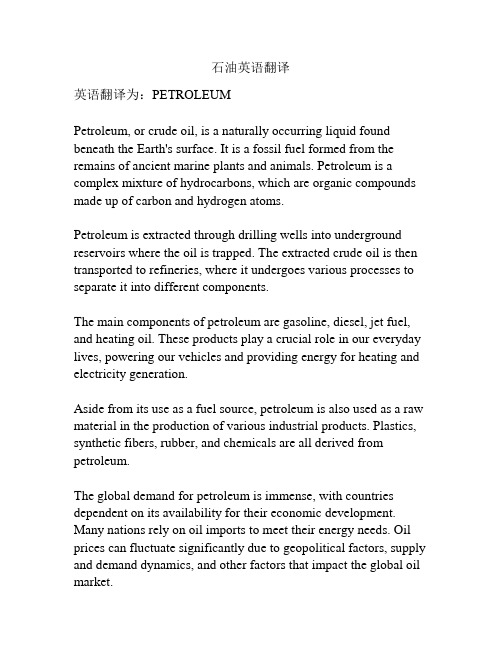
石油英语翻译英语翻译为:PETROLEUMPetroleum, or crude oil, is a naturally occurring liquid found beneath the Earth's surface. It is a fossil fuel formed from the remains of ancient marine plants and animals. Petroleum is a complex mixture of hydrocarbons, which are organic compounds made up of carbon and hydrogen atoms.Petroleum is extracted through drilling wells into underground reservoirs where the oil is trapped. The extracted crude oil is then transported to refineries, where it undergoes various processes to separate it into different components.The main components of petroleum are gasoline, diesel, jet fuel, and heating oil. These products play a crucial role in our everyday lives, powering our vehicles and providing energy for heating and electricity generation.Aside from its use as a fuel source, petroleum is also used as a raw material in the production of various industrial products. Plastics, synthetic fibers, rubber, and chemicals are all derived from petroleum.The global demand for petroleum is immense, with countries dependent on its availability for their economic development. Many nations rely on oil imports to meet their energy needs. Oil prices can fluctuate significantly due to geopolitical factors, supply and demand dynamics, and other factors that impact the global oil market.However, the overreliance on petroleum has raised concerns about its environmental impact. The combustion of petroleum products releases carbon dioxide and other greenhouse gases, contributing to climate change. Oil spills during extraction or transportation can also have devastating effects on the environment, harming marine life and ecosystems.As a result, there is a growing focus on finding alternative sources of energy to reduce our dependence on petroleum. Renewable energy sources such as solar, wind, and hydroelectric power are being explored as more sustainable alternatives.In conclusion, petroleum is a valuable resource that has played a significant role in driving economic growth and development. However, its use comes with environmental consequences. Moving towards more sustainable energy sources is crucial for mitigating the impact of petroleum on the environment and ensuring a greener future.。
(完整版)石油工程专业英语【课文翻译】
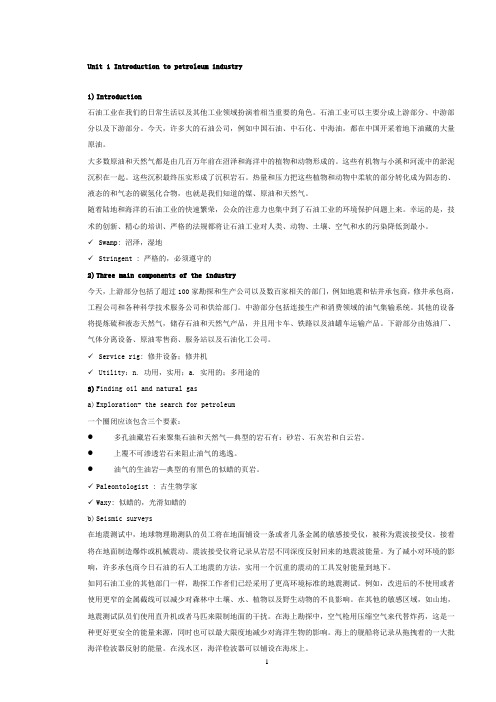
Unit 1 Introduction to petroleum industry1) Introduction石油工业在我们的日常生活以及其他工业领域扮演着相当重要的角色。
石油工业可以主要分成上游部分、中游部分以及下游部分。
今天,许多大的石油公司,例如中国石油、中石化、中海油,都在中国开采着地下油藏的大量原油。
大多数原油和天然气都是由几百万年前在沼泽和海洋中的植物和动物形成的。
这些有机物与小溪和河流中的淤泥沉积在一起。
这些沉积最终压实形成了沉积岩石。
热量和压力把这些植物和动物中柔软的部分转化成为固态的、液态的和气态的碳氢化合物,也就是我们知道的煤、原油和天然气。
随着陆地和海洋的石油工业的快速繁荣,公众的注意力也集中到了石油工业的环境保护问题上来。
幸运的是,技术的创新、精心的培训、严格的法规都将让石油工业对人类、动物、土壤、空气和水的污染降低到最小。
✓Swamp: 沼泽,湿地✓Stringent : 严格的,必须遵守的2) Three main components of the industry今天,上游部分包括了超过100家勘探和生产公司以及数百家相关的部门,例如地震和钻井承包商,修井承包商,工程公司和各种科学技术服务公司和供给部门。
中游部分包括连接生产和消费领域的油气集输系统。
其他的设备将提炼硫和液态天然气,储存石油和天然气产品,并且用卡车、铁路以及油罐车运输产品。
下游部分由炼油厂、气体分离设备、原油零售商、服务站以及石油化工公司。
✓Service rig: 修井设备;修井机✓Utility:n. 功用,实用;a. 实用的;多用途的3) Finding oil and natural gasa)Exploration- the search for petroleum一个圈闭应该包含三个要素:●多孔油藏岩石来聚集石油和天然气—典型的岩石有:砂岩、石灰岩和白云岩。
●上覆不可渗透岩石来阻止油气的逃逸。
石油发展的英语作文带翻译
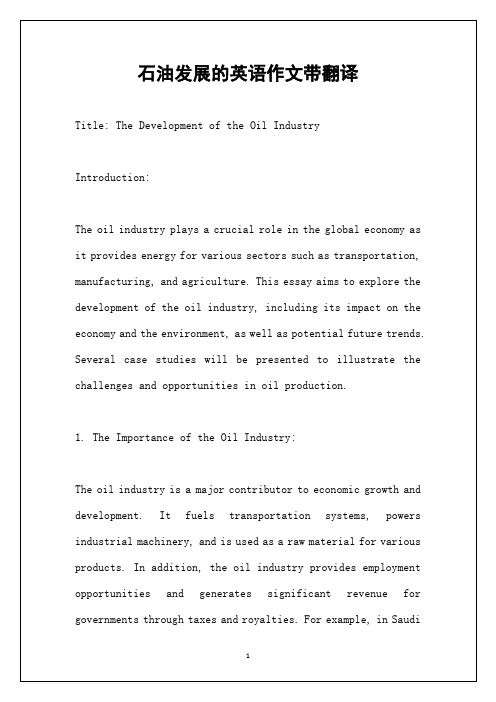
The oil industry is a major contributor to economic growth and development. It fuels transportation systems, powers industrial machinery, and is used as a raw material for various products. In addition, the oil industry provides employment opportunities and generates significant revenue for governments through taxes and royalties. For example, in SaudiArabia, oil accounts for around 90% of the government's revenue.
石油发展的英语作文带翻译
Title: The Development of the Oil Industry
Introduction:
The oil industry plays a crucial role in the global economy as it provides energy for various sectors such as transportation, manufacturing, and agriculture. This essay aims to explore the development of the oil industry, including its impact on the economy and the environment, as well as potential future trends. Several case studies will be presented to illustrate the challenges and opportunities in oil production.
石油类英文翻译文献Strategic Importance Of Crude Oil And Natural GasPipelines
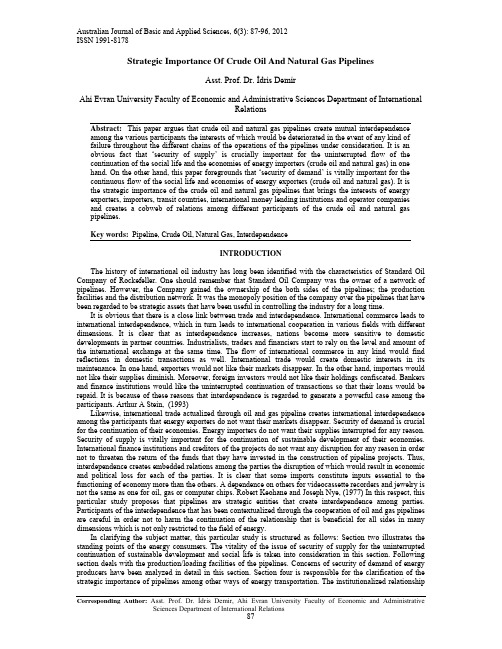
Australian Journal of Basic and Applied Sciences, 6(3): 87-96, 2012ISSN 1991-8178Strategic Importance Of Crude Oil And Natural Gas PipelinesAsst. Prof. Dr. İdris DemirAhi Evran University Faculty of Economic and Administrative Sciences Department of InternationalRelationsAbstract: This paper argues that crude oil and natural gas pipelines create mutual interdependence among the various participants the interests of which would be deteriorated in the event of any kind of failure throughout the different chains of the operations of the pipelines under consideration. It is an obvious fact that ‘security of supply’ is crucially important for the uninterrupted flow of the continuation of the social life and the economies of energy importers (crude oil and natural gas) in one hand. On the other hand, this paper foregrounds that ‘security of demand’ is vitally important for the continuous flow of the social life and economies of energy exporters (crude oil and natural gas). It is the strategic importance of the crude oil and natural gas pipelines that brings the interests of energy exporters, importers, transit countries, international money lending institutions and operator companies and creates a cobweb of relations among different participants of the crude oil and natural gas pipelines.Key words: Pipeline, Crude Oil, Natural Gas, InterdependenceINTRODUCTIONThe history of international oil industry has long been identified with the characteristics of Standard Oil Company of Rockefeller. One should remember that Standard Oil Company was the owner of a network of pipelines. However, the Company gained the ownership of the both sides of the pipelines; the production facilities and the distribution network. It was the monopoly position of the company over the pipelines that have been regarded to be strategic assets that have been useful in controlling the industry for a long time.It is obvious that there is a close link between trade and interdependence. International commerce leads to international interdependence, which in turn leads to international cooperation in various fields with different dimensions. It is clear that as interdependence increases, nations become more sensitive to domestic developments in partner countries. Industrialists, traders and financiers start to rely on the level and amount of the international exchange at the same time. The flow of international commerce in any kind would find reflections in domestic transactions as well. International trade would create domestic interests in its maintenance. In one hand, exporters would not like their markets disappear. In the other hand, importers would not like their supplies diminish. Moreover, foreign investors would not like their holdings confiscated. Bankers and finance institutions would like the uninterrupted continuation of transactions so that their loans would be repaid. It is because of these reasons that interdependence is regarded to generate a powerful case among the participants. Arthur A Stein, (1993)Likewise, international trade actualized through oil and gas pipeline creates international interdependence among the participants that energy exporters do not want their markets disappear. Security of demand is crucial for the continuation of their economies. Energy importers do not want their supplies interrupted for any reason. Security of supply is vitally important for the continuation of sustainable development of their economies. International finance institutions and creditors of the projects do not want any disruption for any reason in order not to threaten the return of the funds that they have invested in the construction of pipeline projects. Thus, interdependence creates embedded relations among the parties the disruption of which would result in economic and political loss for each of the parties. It is clear that some imports constitute inputs essential to the functioning of economy more than the others. A dependence on others for videocassette recorders and jewelry is not the same as one for oil, gas or computer chips. Robert Keohane and Joseph Nye, (1977) In this respect, this particular study proposes that pipelines are strategic entities that create interdependence among parties. Participants of the interdependence that has been contextualized through the cooperation of oil and gas pipelines are careful in order not to harm the continuation of the relationship that is beneficial for all sides in many dimensions which is not only restricted to the field of energy.In clarifying the subject matter, this particular study is structured as follows: Section two illustrates the standing points of the energy consumers. The vitality of the issue of security of supply for the uninterrupted continuation of sustainable development and social life is taken into consideration in this section. Following section deals with the production/loading facilities of the pipelines. Concerns of security of demand of energy producers have been analyzed in detail in this section. Section four is responsible for the clarification of the strategic importance of pipelines among other ways of energy transportation. The institutionalized relationship Corresponding Author: Asst. Prof. Dr. İdris Demir, Ahi Evran University Faculty of Economic and Administrative Sciences Department of International Relationsamong energy producers, consumers, transit states and participant companies are scrutinized in this section of the study. The interdependence of the relevant parties is covered in section five. The cobweb of relations that expands beyond the boundaries of cooperation on energy field is provided in detail in this section with different examples.2. Security of Supply for Energy Importers:Energy is defined as the capability to do work. Every kind of economic activity requires an amount of energy consumption. Automobiles need energy to travel from one place to another. Factories need energy for the production of goods and items. Household items in kitchens and living rooms need energy to operate the appliances. It is the basic and sole responsibility of the policy makers of the countries to secure the necessary amount of energy forms for the uninterrupted continuation of the economic and social life of their countries.In this respect, energy security can be regarded to be a state of being that the policy makers has clear indicatives to believe that they have enough reserves and production and distribution facilities in place to meet the energy demands of their citizens with affordable prices. The situation is regarded to be insecure when the well being of the citizens and/or the capability of governments are threatened either as a result of physical failure arising from sabotage, accidents or inadequacy of the existing structures. Governments may be unable to meet the necessary amounts of energy because of the rise in energy prices, too. (Robert Belgrave, Charles Ebinger and Hideaki Okino, 1987) There would be the adequate amounts of energy forms in presence but the budget of the country may not be able to meet the required amounts of funds to meet the energy demands. Therefore, energy security is described as the availability of energy at all times, in various forms, in sufficient quantities at affordable prices. (Philip Andrews-Speed, 2002)A sudden rise in energy prices and a kind of a physical disruption for any reason may have devastating effects on energy importing countries. It is not only the negative economic effects that should be taken into consideration, but political and social deficiencies should be indicated as well. Lacking sufficient amounts of energy supplies would result in low levels of industrial output. There would be a decline in new investments. Unemployment would increase and inflation rate would rise because of the absence of economic progress. There is going to be a balance of payments problem within the budget calculations of the country. The amount of funds that has been paid for the energy imports would rise. The balance of payment calculations would face a serious new arrangement. (Michael Lynch, 2003) Consumer countries would have two options: They are going to either reflect the high prices directly to the citizens or employ protectionist policies. The governments would look for sources of funds or borrow money from abroad.In either case there would be a kind of money transfer from the consumer countries to the producer countries. The amount of the supernormal profit that producer countries acquire from this newly developed relationship would have different reflections over the political economy in the global scale. (David Grene, 1998) In addition to deteriorating economic conditions, energy importers would fall into weak bargaining positions in their mutual relations regarding their export sources. Energy importers would not be able to act as flexible as they used to be in both domestic and international political issues. Therefore, energy importers tend to create long lasting friendly relationships with energy exporters. The functional use of long term agreements among producers and consumers make parties feel secure in times of crisis that results from either a physical shortage in the global markets or the scarcity of energy forms because of political reasons. (Gawdat Bahgat, 2004) In addition to economic and social considerations, energy items are regarded to be strategic goods that have the capability to determine and/or change the continuation and the fate of a war. Lacking adequate amounts of hydrocarbon resources can bring the consuming countries into her knees quickly. The main motive of Germany in invading Russia was the aim of accessing the hydrocarbon resources of the Soviet Union. It is widely accepted that the fate of the war, consequently, the whole world might have been different if Germany had access to the hydrocarbon sources under discussion. It is not only in the Second World War that hydrocarbon energy has determined the status and the continuation of the war. The British decision of changing the fuel of the ships of the Navy from coal to oil had detrimental impacts upon the stages of the First World War. Oil burning appliances of the British Navy made it possible to have longer distances of travel in a faster course than her rivals, thus determining an advantageous position for Britain. (Hikmet Uluğbay, 2003) There are a number of events that can be regarded as potential threats to energy security. These threats are categorized as the events that have global impact and events that have impact on a specific country or a region. Special emphasis is needed to shed light on the latter group since the content of this particular study focuses on pipelines. Oil and gas pipelines are strategic assets that combine the consumers and producers together. Energy forms are meaningless and valueless if they are not available to be used at the point of consumption. The possibility of a disruption arising from misuse or inability of the operation of pipeline structures that bring the interests of loading and unloading parties together would have devastating effects on the security of energy supply calculations of a particular country and/or region. It is an actual fact that the failure of pipelines to operate would have a reflection in the global energy considerations, too. However, the extent of the pressure andthe strength of this effect would be proportional directly to the amount of energy transported through the pipeline and the amount of the contribution of that particular pipeline in openness to the global markets.Embargo disruption of a specific exporting state may result in a threat of security of supply of a local scale. It can place a heavy burden over the importing country especially in the short period if the existing structure of the energy importing country fails to respond the change in circumstances immediately. Embargo disruption may come necessarily not from the exporter states but from the transit countries as well. The closure of the pipeline structures, with no doubt, would have devastating effects upon the economies, politics and social lives of importer countries. (Paul Stevens, 2000) The devastating effects would be vital and even at life threatening levels if the importing country is landlocked; does not have access to high seas. The absence of maritime lines would make transportation of energy via energy carrying ships impossible; laying road transportation via trucks and trains alone. It is doubtful whether the geography and already existing infrastructure would make it possible to carry the necessary forms of energy in adequate amounts.Local market disruptions are other issues of concern that have to be dealt carefully for consumer countries that try to secure the necessary forms of energy for uninterrupted flow of sustainable development of their country. There can be disruptions in energy flow because of a monopolist supplier or some pressure groups the interests of which can be deteriorated. Mismanagement of the policy makers is another reason that can result in local market disruptions. In either case, the responsibility lies over the shoulders of the governing authorities to diversify the energy sources and suppliers within the primary energy mix of the energy importing country. Furthermore, enhancing regulative means of energy consumption is another responsibility of the authorities in achieving the aim of the security of supply.The disruption of the strategic infrastructure of any kind is another serious threat to the calculations of the security of supply. Logistical disruptions may occur in the event of accidents, sabotage activities or terrorist incidents along the route of the transportation infrastructure. In this case, terrorist activities of some groups can no longer be regarded as the responsibility of the host government alone. All parties are affected negatively from these activities the prevention of which need collective action of all sides. (Anne Korin, 2005) The interests of all parties that are seeking security of demand and security of supply would be deteriorated. The authorities of both ends of the pipeline would attach a great importance to the well functioning of that strategic infrastructure.3. Security of Demand for Energy Exporters:The examination of the notion of the security of demand is an important but, often, a neglected issue. The vitality of the security of energy supply for energy consumers finds its reflection as the importance of the security of demand for producers.It should be remembered that revenues coming from the energy trade are the backbone of the budgets of the exporting countries. The economy of the whole country depends on one single item: hydrocarbon earnings. Economies of energy exporters in general (Countries such as Great Britain) lack the existence of a well functioning industry, tourism earnings, surplus in trade of goods and items. The bureaucratic structure is built on the oil and gas industries at the same time. It is because of the negative effects of the Dutch Disease that the balance of payments calculations do not show healthy indications. (M Corden, 1984) The concept of ‘state’ changes form and is regarded to be the mechanism of the distribution of wealth and welfare based on subjective calculations rather than following a process of collecting taxes and directs the expenditures of the budget for the benefit of the existing and future generations. It is the industry sector that is mostly affected from the negative consequences in industrialized countries. However, it is the agriculture sector that suffers from the biggest negative effects. (Paul Stevens, 2003)The members of the Organization of Petroleum Exporting Countries (OPEC) suffer from the negative consequences of this unbalanced balance of payments. Trade balances of the OPEC members have indicators of exporting one single item –energy sources- and import almost all of the consumption of the country. Energy exporters, the economies of which are dependant almost entirely on energy earnings, would experience an unstable economic ground both in domestic and international affairs. It is going to be hard to follow efficient fiscal policies and direct future investments. Domestic fiscal policies would be tied to international energy prices that are bound to global developments in which the exporter states may not have a big effect. (Kiren Chaudhry, 1989)The dependence of economy on energy earnings is peculiar not only to OPEC members. Other major exporters depend on energy earnings heavily, too. The threat of Rentier State structuring shows its reflections in Non-OPEC members at the same time. The ‘dependence’ of energy earnings makes it necessary for exporters to seek for markets and continue to supply them with oil and gas for the continuation of the cycle of their domestic economies.Two major threats for security of demand can be categorized as the loss of the market share of hydrocarbon energy sources in general and the deterioration of the market share of the exporting country in particular. Unsteady flow of oil and gas to global markets with unaffordable prices will result in articulations of differentforms of energy. The importance attached to renewable and alternative energy forms will be fore grounded in accordance with the developments, new findings and advancements in energy forms that are regarded to be used instead of hydrocarbon resources. Consequently, there would be less demand for hydrocarbon sources in general and possible future earnings of energy exporters would be cut off.Apart from the potential threat of the losing the share of hydrocarbon sources within the primary energy mix of the countries in global scale, the loss of the market share of a single exporting country would have fatal consequences for that particular country. It is a well known fact that energy importers attach great importance to long term sales agreements with particular exporters rather than the spot trade in the international market. In the event of the absence of the supplier, consumer countries would find new suppliers and conclude new deals. Thus, the energy exporters would face a loss in the market share and security of demand for her energy sources.Securing the flow of energy in the future with long term sales agreements is paramount to the strategies of consumer countries in one hand. Securing the income coming from the future sales of the contracted trade occupies a vital place within the revenue calculations of the exporting states on the other hand. Therefore, two sides of the same coin should be taken into consideration together. No one party has the intention or desire to harm the ongoing relationship. Deteriorating neither the security of demand nor the security of supply would be beneficial to both sides. In this context, it should not be forgotten that oil and gas pipelines acquire a strategic significance in the sense that infrastructures under consideration combine the producers and consumers together. Both ends of the pipeline attach great importance to the continuous, uninterrupted flow of energy from the production fields to the points of consumption. In this respect, pipelines create cobweb of relations not only in political terms, but also in physical aspects as well. It is with no doubt that none of the parties involved in the relationship would have the intention of the disruption of the relationship which would mean the deterioration of the interests of all parties. In this respect, pipelines combine the consumers, producers and the transit countries together in strategic terms with long lasting relationships.4. Strategic Importance of Pipeline Transportation:Any form of energy is meaningless unless it is ready to use in the final consumption point. The fact that oil and gas resources are not distributed homogeneously makes it necessary to transport these energy sources from the production fields to the consumption centers. The issue of transportation has gained a significant importance as the levels of consumption and the proven oil and gas reserves increase.Levels of oil and gas consumption increase with the rise in living standards and the rise in the levels of industrialization. Higher levels of living standards and industrialization bring the inevitable consumption of energy sources in higher amounts. However, it is a fact that current reserves that are close to the traditional consumption centers are either declining or about to reach to the declining phase. This brings the significant importance of transportation into agenda.There are a couple of ways that are used widely in order to transport oil and gas from the production facilities to the consumption points. Transportation ways that are generally used are pipelines, crude oil and Liquefied Natural Gas (LNG) ships, huge trucks and some sort of specially designed railway storage tanks. The most suitable way of transportation is determined by geology, geography, and the type of energy and the economies of scale. (Paul Stevens, 2001)Pipelines and tanker carriages via high seas are the most common types of transportation that link the production and consumption points. Since the control of the pipelines has all the potentialities for the control of the petroleum industry, they have long been recognized as the most important means of transportation in the petroleum industry. (Roy A Prewitt, 1942) Likewise, although an amount of gas transportation has been conducted by LNG ships, gas transportation via pipelines has been of crucial importance.The decision of constructing a pipeline requires many calculations that include strategic outcomes at the same time. The investment decision of a pipeline depends upon the evaluation of future demand. (Jerome Ellig and Jack High 1992) Moreover, it is very important to evaluate the safety and reliability of these complex and large scaled systems. (Dong Yuhua and Yu Datao, 2005) In this respect, maintenance of pipelines is an issue of great concern for both companies and governments. Any possibility of leakage, for example, must be detected before the leakage takes place and preventive action should be taken in order to avoid losses of energy and ecological disasters. (d Jun Okamoto, 1999)Therefore, it is not only economics and politics that are taken into consideration in the investment decisions of pipelines; there are a couple of different issues such as ecological considerations, geographical and geological conditions that should be taken into granted throughout this complex context.Once constructed, pipelines are not possible to be removed or rerouted. (Once operational) They attract economies of scale in great amounts like other stages of the international oil and gas industry. Thus, ‘big is beautiful and small is stupid’ in the investment decisions of pipelines. Big numbers mean big calculations and huge losses in the event of a failure of any kind. The effects and the application of ‘Bygones rule’ is another issue of concern that has to be taken into consideration throughout the operation record of oil and gas pipelines.It is because of this fact that pipelines continue to operate and their activities are not shut down for a considerable period of time even if they are making losses.The configuration of the network and sizes of pipes used must be chosen to minimize the construction costs. (Jack Brimberg, Pierre Hansen, Keh-Wei Lih,) In addition to construction costs, other issues relevant to the successful operation of the pipeline require careful examination, too. The transportation issues preferred by governments and companies must not only take the economic risks into account but also consider the negative effects of possible terrorist activities, changes in the policies of the participants and trade embargoes over the long period of the projected operation of the pipeline. (Sydney Thomas and Richard Dawe, 2003) In addition to that, the amount of oil that can be put through the pipe varies with the initial pressure of the petroleum, the loss of pressure per square inch per mile, the density of the liquid, the viscosity and unique characteristics of the fluid handled, the diameter of the pipe and the geographical features of the landscape on the route of the pipeline. (A C Monahan, 1945)The complex structuring of pipeline facilities can be reviewed closer through the analysis of transportation of offshore oil and gas products. The first section of the analysis is the riser or the rigid section of piping. This conveys the fluids from the production facilities to the seabed (and vice versa). Failure of this section would affect the production platform and production personnel. Second section of the process concerns the sea line that transports the fluids to the shore. Any kind of failure in this stage would result in losses in shipping and potential environmental pollution. The third section of this process involves the land section. The energy items that are produced offshore and transported reach the ground. Any kind of failure resulting from accidents or sabotage would have detrimental affects on the public. The final section is the landline that is buried under the ground. This can be of any length in reaching to the final consumption centers. It is with no doubt that failure of this section would result in devastating environmental effects. (F K Crawley, I G Lines and J Mather, 2003) Furthermore, security of demand, security of supply and transit fee calculations of the relevant parties would also face potential threats.It is obvious that the construction of a pipeline require a transit agreement among the parties. This agreement may involve competition for markets and competition for volumes. It is because of this feature that pipeline agreements involve different governments and, may be, different companies. Producing governments would have different objections on one hand, on the other hand consumer governments and transit governments would have objectives of their own. Moreover the inclusion of contractor companies would add another dimension to the discussion under consideration. While the objectives of the governments are going to be determined by the considerations of security of supply and demand and the principle of sovereignty, contractor companies would seek for pure commercial considerations. (Paul Stevens, 2003) Producer countries would demand high price for their energy exports. Consumer countries would look for a small bill for their imports. Transit countries would require high amounts of transit fees and greater amounts of off take from the pipeline for their domestic consumption with favorable prices. Contractor companies, on the other hand, would seek for greater economic rent and share from the operation of the facilities of pipelines under consideration.The fact that the pipelines cross borders of different nation states makes it inevitable to be influenced by different legal regimes. The possibility of the presence of different legal regimes and regulations makes it necessary to bring various legal terms and norms together within the initializing the transit agreement. The process of harmonization of different legal regimes should be wide enough to cover the potential changes throughout the continuation of the activities of the pipeline for the success of the operation. Therefore, the distribution of benefits and sovereign rights should be well determined and documented to cover the long period of the long operation time of the pipeline project. (Paul Stevens,)It should not be forgotten that the technical features that embody the construction phase have detrimental impacts upon the continuation of the operation of the pipelines. Pipelines have large upfront investments. They have high fixed costs and low variable costs. Once they are built, it is hard to apply a change in the capacity of the pipeline. Therefore, it is very important to apply careful and just calculations in the formation process of pipelines that are regarded to be natural monopolies that combine the relevant parties strategically in long lasting terms. The key to the success of the operations of pipelines lies in the fact that the agreements would take the change in circumstances in time into account throughout the duration of the activities of the pipeline. The success of the operations of the pipeline should not be left to the bargaining powers of the parties alone at the initial stages. (Ekpen J Omonbude, 2007)The issue of pipelines requires a greater attention when the transportation of natural gas is taken into consideration. Natural gas is a clean burning fuel that is used to heat homes, hospitals, schools; generate electricity and fuel industries. The usage of natural gas varies from plastics and petrochemicals to fertilizer producers. (Obindah Wagbara, 2007) The fact that natural gas is a clean burning fuel that is compatible with environmental considerations has led the way to the issue that natural gas has become the energy medium choice for many governments and environmental groups throughout the world (Ferdinand E. Banks, 2003). In fact, the reason why natural gas do not acquire the dominant seat within the primary energy mix of consumer states is hidden in the clean characteristic of this fuel besides the problems of transportation. Natural gas has been。
科技英语的文体特征及翻译策略——以石油英语翻译为例
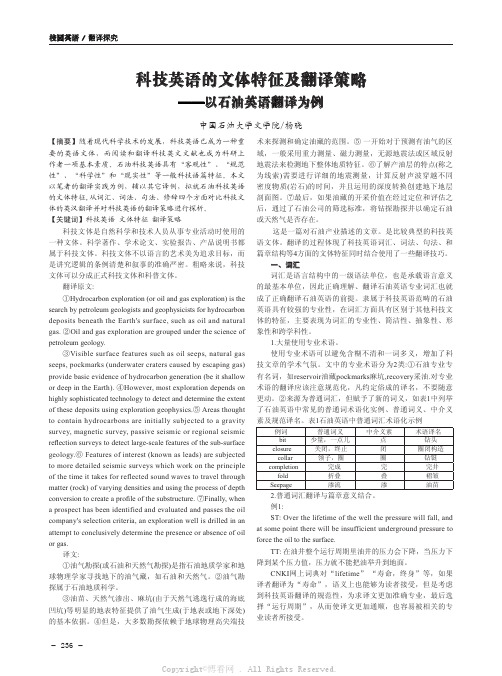
- 236-校园英语 / 翻译探究科技英语的文体特征及翻译策略——以石油英语翻译为例中国石油大学文学院/杨晓【摘要】随着现代科学技术的发展,科技英语已成为一种重要的英语文体,而阅读和翻译科技英文文献也成为科研上作者一项基本素质。
石油科技英语具有“客观性”、“规范性”、“科学性”和“现实性”等一般科技语篇特征。
本文以笔者的翻译实践为例,辅以其它译例,拟就石油科技英语的文体特征,从词汇、词法、句法、修辞四个方面对比科技文体的英汉翻译并对科技英语的翻译策略进行探析。
【关键词】科技英语 文体特征 翻译策略科技文体是自然科学和技术人员从事专业活动时使用的一种文体。
科学著作、学术论文、实验报告、产品说明书都属于科技文体。
科技文体不以语言的艺术美为追求目标,而是讲究逻辑的条例清楚和叙事的准确严密。
粗略来说,科技文体可以分成正式科技文体和科普文体。
翻译原文:①Hydrocarbon exploration (or oil and gas exploration) is the search by petroleum geologists and geophysicists for hydrocarbon deposits beneath the Earth's surface, such as oil and natural gas. ②Oil and gas exploration are grouped under the science of petroleum geology.③Visible surface features such as oil seeps, natural gas seeps, pockmarks (underwater craters caused by escaping gas) provide basic evidence of hydrocarbon generation (be it shallow or deep in the Earth). ④However, most exploration depends on highly sophisticated technology to detect and determine the extent of these deposits using exploration geophysics.⑤ Areas thought to contain hydrocarbons are initially subjected to a gravity survey, magnetic survey, passive seismic or regional seismic reflection surveys to detect large-scale features of the sub-surface geology.⑥ Features of interest (known as leads) are subjected to more detailed seismic surveys which work on the principle of the time it takes for reflected sound waves to travel through matter (rock) of varying densities and using the process of depth conversion to create a profile of the substructure. ⑦Finally, when a prospect has been identified and evaluated and passes the oil company's selection criteria, an exploration well is drilled in an attempt to conclusively determine the presence or absence of oil or gas.译文:①油气勘探(或石油和天然气勘探)是指石油地质学家和地球物理学家寻找地下的油气藏,如石油和天然气。
浅议石油英语的特点及其翻译策略
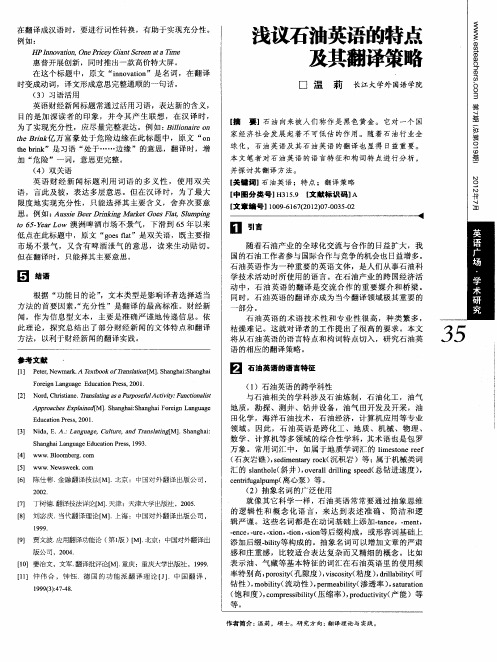
部分。
石油英 语 的术语 技术性 和专 业性 很高 ,种类 繁多 , 枯 燥 难 记 。 这 就 对 译 者 的 工 作 提 出 了 很 高 的要 求 。 本 文 将 从 石 油 英 语 的 语 言 特 点 和 构 词 特 点 切 入 ,研 究石 油 英 语 的 相应 的翻 译策 略 。
i 言 l l引
随着 石油产 业的全球化 交流与合 作的 日益扩大 ,我 国的石油工作者参与国际合作与竞争的机 会也 目益 增多。 石油英语作 为一种重要 的英语文体 ,是人们从 事石油科 学技术活动 时所使用 的语 言 。在石 油产业 的跨 国经济活 动 中,石油 英语 的翻译 是交流 合作 的重要媒 介和 桥梁 。 同时 ,石油 英语 的翻译亦 成为 当今 翻译领域极其 重要 的
但 在 翻 译 时 ,只 能 择 及其翻译策略
口 温 莉 长江大学外国 语学 院
【 摘
要 】石 油 向来 被 人 们 称 作 是 黑 色 黄 金 。 它 对 一 个 国
家 经 济 社 会 发 展 起 着 不 可 低 估 的作 用 。 随 着 石 油 行 业 全
3 5
[] P tr wma . e to ko rnlt n M]S a g a:h n h i 1 ee Ne , r A Txb o fT s i [ . h n h i a g a k a ao S
F r in La g a e Ed c t nPr s, 0 1 o e g n u g u ai e s 2 0 . o
一
目 结 语
根 据 “ 能 目的论 ” 文 本 类 型 是 影 响 译 者 选 择 适 当 功 ,
方法 的首要 因素, 充分性 ”是翻译 的最高标准 。财经新 “ 闻,作为信息 型文本 ,主要 是准确严 谨地传递信 息。依
英语翻译实习心得体会5篇
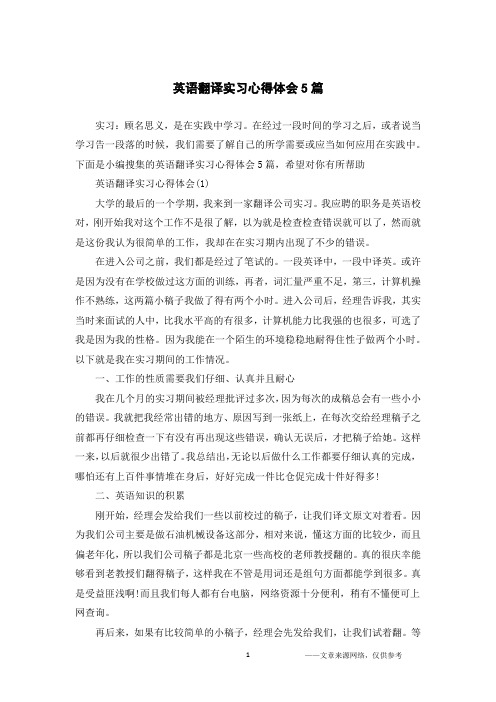
英语翻译实习心得体会5篇实习:顾名思义,是在实践中学习。
在经过一段时间的学习之后,或者说当学习告一段落的时候,我们需要了解自己的所学需要或应当如何应用在实践中。
下面是小编搜集的英语翻译实习心得体会5篇,希望对你有所帮助英语翻译实习心得体会(1)大学的最后的一个学期,我来到一家翻译公司实习。
我应聘的职务是英语校对,刚开始我对这个工作不是很了解,以为就是检查检查错误就可以了,然而就是这份我认为很简单的工作,我却在在实习期内出现了不少的错误。
在进入公司之前,我们都是经过了笔试的。
一段英译中,一段中译英。
或许是因为没有在学校做过这方面的训练,再者,词汇量严重不足,第三,计算机操作不熟练,这两篇小稿子我做了得有两个小时。
进入公司后,经理告诉我,其实当时来面试的人中,比我水平高的有很多,计算机能力比我强的也很多,可选了我是因为我的性格。
因为我能在一个陌生的环境稳稳地耐得住性子做两个小时。
以下就是我在实习期间的工作情况。
一、工作的性质需要我们仔细、认真并且耐心我在几个月的实习期间被经理批评过多次,因为每次的成稿总会有一些小小的错误。
我就把我经常出错的地方、原因写到一张纸上,在每次交给经理稿子之前都再仔细检查一下有没有再出现这些错误,确认无误后,才把稿子给她。
这样一来,以后就很少出错了。
我总结出,无论以后做什么工作都要仔细认真的完成,哪怕还有上百件事情堆在身后,好好完成一件比仓促完成十件好得多!二、英语知识的积累刚开始,经理会发给我们一些以前校过的稿子,让我们译文原文对着看。
因为我们公司主要是做石油机械设备这部分,相对来说,懂这方面的比较少,而且偏老年化,所以我们公司稿子都是北京一些高校的老师教授翻的。
真的很庆幸能够看到老教授们翻得稿子,这样我在不管是用词还是组句方面都能学到很多。
真是受益匪浅啊!而且我们每人都有台电脑,网络资源十分便利,稍有不懂便可上网查询。
再后来,如果有比较简单的小稿子,经理会先发给我们,让我们试着翻。
语义翻译和交际翻译指导下的石油英语翻译
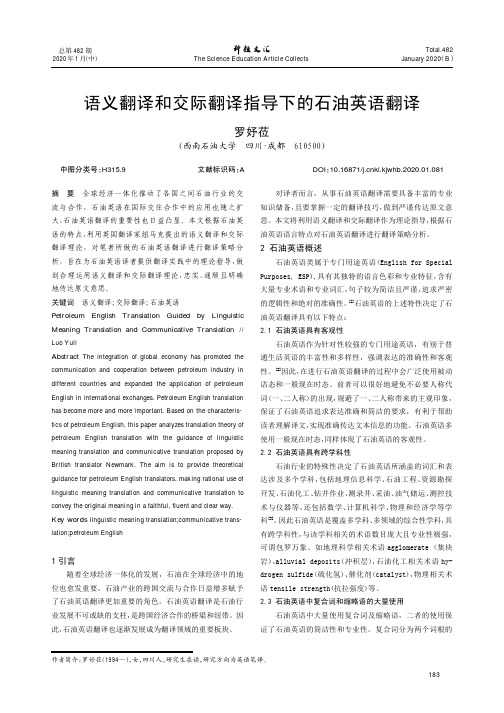
The Science Education Article CollectsTotal.482 January2020(B)总第482期2020年1月(中)摘要全球经济一体化推动了各国之间石油行业的交流与合作,石油英语在国际交往合作中的应用也随之扩大,石油英语翻译的重要性也日益凸显。
本文根据石油英语的特点,利用英国翻译家纽马克提出的语义翻译和交际翻译理论,对笔者所做的石油英语翻译进行翻译策略分析,旨在为石油英语译者提供翻译实践中的理论指导,做到合理运用语义翻译和交际翻译理论,忠实、通顺且明确地传达原文意思。
关键词语义翻译;交际翻译;石油英语Petroleum English Translation Guided by Linguistic Meaning Translation and Communicative Translation// Luo YuliAbstract The integration of global economy has promoted the communication and cooperation between petroleum industry in different countries and expanded the application of petroleum English in international exchanges.Petroleum English translation has become more and more important.Based on the characteris-tics of petroleum English,this paper analyzes translation theory of petroleum English translation with the guidance of linguistic meaning translation and communicative translation proposed by British translator Newmark.The aim is to provide theoretical guidance for petroleum English translators,making rational use of linguistic meaning translation and communicative translation to convey the original meaning in a faithful,fluent and clear way. Key words linguistic meaning translation;communicative trans-lation;petroleum English1引言随着全球经济一体化的发展,石油在全球经济中的地位也愈发重要。
石油词汇英语翻译(C5篇)3

carbonaceous fragment 碳质碎屑carbonaceous meteorites 含碳陨⽯carbonaceous rock 碳质岩carbonaceous sediment 碳质沉积carbonaceous shale 碳质页岩carbonaceous slate 碳质板岩carbonaceous 碳的carbonado bit ⿊⾦刚⽯钻头carbonado ⿊⾦刚⽯;烧carbonatation 碳酸盐化carbonate algal stromatolite 钙藻叠层⽯carbonate analysis log 碳酸盐岩分析录井carbonate bank 碳酸盐岩滩carbonate breccia 碳酸盐岩⾓砾⽯carbonate buildup 碳酸盐建隆carbonate compensation depth 碳酸盐补偿深度carbonate compensation level 碳酸盐补偿⾯carbonate conglomerate 碳酸盐岩砾岩carbonate content 碳酸盐含量carbonate deposition 碳酸盐沉积carbonate formation 碳酸盐岩地层carbonate mass 碳酸盐岩体carbonate ooze 碳酸盐软泥carbonate platform 碳酸盐岩台地carbonate ramp 碳酸盐缓坡carbonate reef 碳酸盐岩礁carbonate reservoir 碳酸盐岩储层carbonate sedimentary facies 碳酸盐岩沉积相carbonate shelf 碳酸盐岩陆棚carbonate 碳酸盐carbonate-apatite 碳磷灰⽯carbonate-cemented sand 碳酸盐胶结砂岩carbonate-compensation surface 碳酸盐补偿⾯carbonate-evaporite 碳酸盐蒸发岩carbonate-fluorapatite 碳氟磷灰⽯carbonate-hydroxylapatite 碳羟磷灰⽯carbonated water flooding 碳酸⽔驱油carbonated water 碳酸⽔carbonation 碳酸盐法carbonatite 碳酸盐岩carbonatization 碳酸盐化carbonator 碳酸化器Carbonella ⽯炭⾍属carbonic acid gas 碳酸⽓carbonic acid 碳酸carbonic allyl ester 碳酸丙烯酯carbonic ester 碳酸酯Carbonic limestone ⽯炭纪⽯灰岩Carbonic period ⽯炭纪carbonic sandstone 碳质砂岩carbonic snow ⼲冰Carbonic ⽯炭纪carbonic 碳的Carbonicola ⽯炭蚌属carbonide 碳化物Carboniferous glaciation ⽯炭纪冰期Carboniferous period ⽯炭纪Carboniferous system ⽯炭系carboniferous 含碳的Carboniferous ⽯炭纪的carbonification 碳化作⽤carbonite 天然焦炭;碳质炸药carbonitriding 碳氮共渗carbonitrile 腈carbonium ion 阳碳离⼦carbonium 阳碳carbonization process 碳化过程carbonization 碳化carbonized plant tissue 碳化植物组织carbonized polyacrylonitrile fibre 碳化聚丙烯腈纤维carbonnitriding 碳氮共渗;氰化carbonolite 碳质岩carbonolith 碳质沉积岩carbonolyte 碳质岩carbonometer 碳酸计carbonyl bond 羰基键carbonyl chloride 羰基氯carbonyl cobalt 羰基钴carbonyl compound 羰基化物carbonyl group 羰基carbonyl heme 羰合⾎红素carbonyl hemoglobin 碳氧⾎红蛋⽩carbonyl 羰基carbonylation of methanol 甲醇羰基化carbonylation 羰基化carbonyles 羰络物类carbophyre 碳质⽕成岩carbopyrite 碳黄铁矿carborane 碳硼烷carborne detector 车载探测器carborne 汽车转运的carborundum grinding wheel ⾦刚砂轮carborundum paper 砂纸carborundum powder ⾦刚砂粉carborundum 碳化硅carbowax 聚⼄⼆醇carboxy-ended oligomer 羧端基低聚物carboxyethyl cellulose 羧⼄基纤维素carboxyl group 羧基。
大学科技英语课文翻译Unit 1-7
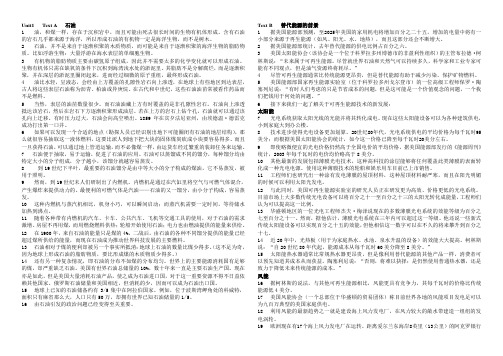
Unit1 Text A 石油1油,和煤一样,存在于沉积岩中,而且可能由死去很长时间的生物有机体形成。
含有石油的岩石几乎都来源于海洋,所以形成石油的有机物一定是海洋生物,而不是树木。
2 石油,并不是来自于逐渐积聚的木质物质,而可能是来自于逐渐积聚的海洋生物的脂肪物质。
比如浮游生物:大量浮游在海水表层的单细胞生物。
3 有机物的脂肪物质主要由碳氢原子组成,因此并不需要太多的化学变化就可以形成石油。
生物有机体只需在缺氧的条件下沉积到海湾浅水处的淤泥里。
其脂肪不是分解腐烂,而是逐渐积聚,并在深层的淤泥里圈闭起来,进而经过细微的原子重组,最终形成石油。
4 油比水轻,呈液态,会经由上方覆盖的孔隙性岩石向上渗透,在地球上有些地区到达表层,古人将这些表层石油称为沥青、柏油或异庚烷。
在古代和中世纪,这些石油油苗常被看作药品而不是燃料。
5 当然,表层的油苗数量很少。
而石油油藏上方有时覆盖的是非孔隙性岩石。
石油向上渗透抵达该岩石,然后在岩石下方逐渐积聚形成油层。
若在上方的岩石上钻个孔,石油就可以通过该孔向上迁移。
有时压力过大,石油会向高空喷出。
1859年在宾夕法尼亚州,由埃德温·德雷克成功打出第一口井。
6 如果可以发现一个合适的地点(勘探人员已经识别出地下可能圈闭有石油的地层结构),那么就很容易抽取这一液体燃料,这要比派人到地下把大块的固体煤炭砍成小块要容易得多。
而且一旦获得石油,可以通过地上管道运输,而不必像煤一样,由运货车经过繁重的装卸任务来运输。
7 石油便于抽取,易于运输,促进了石油的应用。
石油可以蒸馏成不同的馏分,每种馏分均由特定大小的分子组成,分子越小,该馏分就越容易蒸发。
8 到19世纪下半叶,最重要的石油馏分是由中等大小的分子构成的煤油,它不易蒸发,被用于照明。
9 然而,到19世纪末人们研制出了内燃机。
内燃机是通过在汽缸里将空气与可燃气体混合,产生爆炸来提供动力的。
最便利的可燃气体是汽油——石油的又一馏分,由小分子构成,容易蒸发。
Shale Oil Production Process翻译实践报告
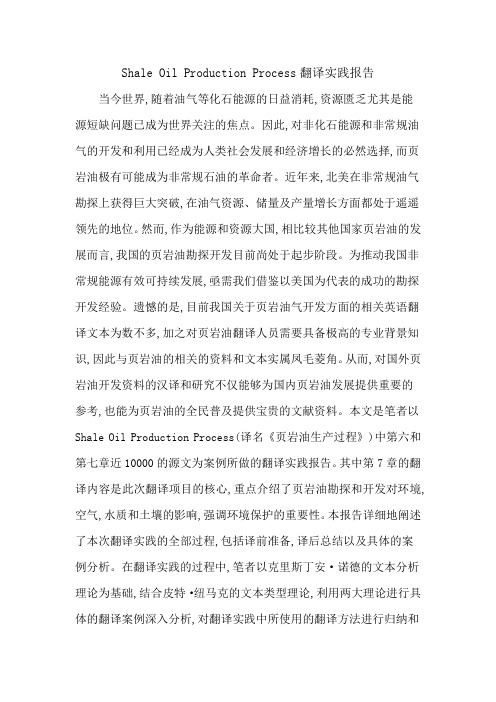
Shale Oil Production Process翻译实践报告当今世界,随着油气等化石能源的日益消耗,资源匮乏尤其是能源短缺问题已成为世界关注的焦点。
因此,对非化石能源和非常规油气的开发和利用已经成为人类社会发展和经济增长的必然选择,而页岩油极有可能成为非常规石油的革命者。
近年来,北美在非常规油气勘探上获得巨大突破,在油气资源、储量及产量增长方面都处于遥遥领先的地位。
然而,作为能源和资源大国,相比较其他国家页岩油的发展而言,我国的页岩油勘探开发目前尚处于起步阶段。
为推动我国非常规能源有效可持续发展,亟需我们借鉴以美国为代表的成功的勘探开发经验。
遗憾的是,目前我国关于页岩油气开发方面的相关英语翻译文本为数不多,加之对页岩油翻译人员需要具备极高的专业背景知识,因此与页岩油的相关的资料和文本实属凤毛菱角。
从而,对国外页岩油开发资料的汉译和研究不仅能够为国内页岩油发展提供重要的参考,也能为页岩油的全民普及提供宝贵的文献资料。
本文是笔者以Shale Oil Production Process(译名《页岩油生产过程》)中第六和第七章近10000的源文为案例所做的翻译实践报告。
其中第7章的翻译内容是此次翻译项目的核心,重点介绍了页岩油勘探和开发对环境,空气,水质和土壤的影响,强调环境保护的重要性。
本报告详细地阐述了本次翻译实践的全部过程,包括译前准备,译后总结以及具体的案例分析。
在翻译实践的过程中,笔者以克里斯丁安·诺德的文本分析理论为基础,结合皮特·纽马克的文本类型理论,利用两大理论进行具体的翻译案例深入分析,对翻译实践中所使用的翻译方法进行归纳和总结。
在详细地解析了影响翻译的文外因素和文内因素后,通过对Shale Oil Production Process的分析研究表明,确定该文本属于信息型和号召型为一体的文本,翻译时要求译文在文体风格,句子结构和词语顺序上接近原文,结合石油英语语言的特点,科技英语翻译的原则以及具体的翻译案例对采取的翻译方法和技巧进行分析和归纳,解决翻译中遇到的困难。
《2024年《伊尔库茨克石油有限责任公司》网页文本翻译实践报告》范文
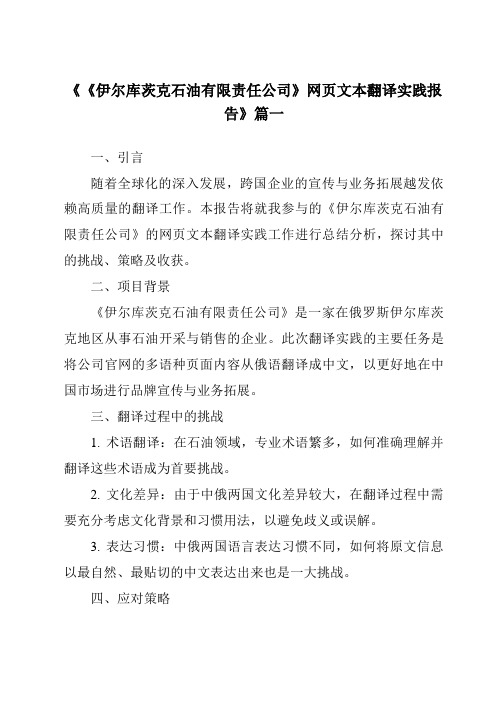
《《伊尔库茨克石油有限责任公司》网页文本翻译实践报告》篇一一、引言随着全球化的深入发展,跨国企业的宣传与业务拓展越发依赖高质量的翻译工作。
本报告将就我参与的《伊尔库茨克石油有限责任公司》的网页文本翻译实践工作进行总结分析,探讨其中的挑战、策略及收获。
二、项目背景《伊尔库茨克石油有限责任公司》是一家在俄罗斯伊尔库茨克地区从事石油开采与销售的企业。
此次翻译实践的主要任务是将公司官网的多语种页面内容从俄语翻译成中文,以更好地在中国市场进行品牌宣传与业务拓展。
三、翻译过程中的挑战1. 术语翻译:在石油领域,专业术语繁多,如何准确理解并翻译这些术语成为首要挑战。
2. 文化差异:由于中俄两国文化差异较大,在翻译过程中需要充分考虑文化背景和习惯用法,以避免歧义或误解。
3. 表达习惯:中俄两国语言表达习惯不同,如何将原文信息以最自然、最贴切的中文表达出来也是一大挑战。
四、应对策略1. 术语研究:在进行翻译前,进行了大量的术语研究工作,确保对每个术语都有准确的理解和翻译。
2. 文化对比:通过对比中俄两国的文化背景和习惯用法,充分考虑目标读者的接受程度,确保翻译内容的准确性和可读性。
3. 请教专家:在遇到难以把握的词汇或句子时,及时向行业专家请教,以确保翻译的准确性。
五、实践过程1. 译前准备:对原文进行深入分析,了解企业文化、业务范围等背景信息,制定详细的翻译计划。
2. 翻译阶段:在确保理解原文的基础上,遵循翻译原则和技巧,进行逐字逐句的翻译。
3. 校对与审稿:完成初稿后,进行多次校对与审稿工作,确保翻译内容的准确性和流畅性。
4. 反馈与修改:根据客户反馈,对翻译内容进行修改和完善。
六、收获与反思1. 知识积累:通过此次翻译实践,我对石油领域的专业术语有了更深入的了解,提高了自己的专业知识水平。
2. 技能提升:在翻译过程中,我不断总结经验教训,提高了自己的翻译技巧和语言表达能力。
3. 跨文化交流能力:通过此次实践,我更加深刻地认识到跨文化交流的重要性,学会了如何更好地理解和适应不同文化背景下的语言表达习惯。
翻译实践报告总结 翻译实践报告范文3篇
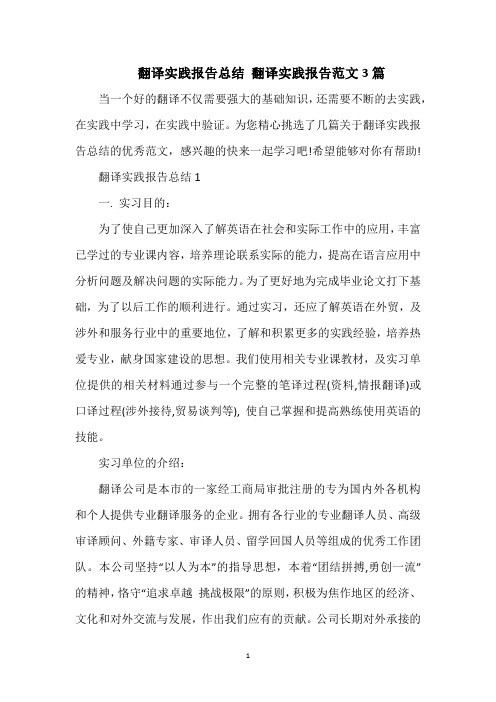
翻译实践报告总结翻译实践报告范文3篇当一个好的翻译不仅需要强大的基础知识,还需要不断的去实践,在实践中学习,在实践中验证。
为您精心挑选了几篇关于翻译实践报告总结的优秀范文,感兴趣的快来一起学习吧!希望能够对你有帮助!翻译实践报告总结1一. 实习目的:为了使自己更加深入了解英语在社会和实际工作中的应用,丰富已学过的专业课内容,培养理论联系实际的能力,提高在语言应用中分析问题及解决问题的实际能力。
为了更好地为完成毕业论文打下基础,为了以后工作的顺利进行。
通过实习,还应了解英语在外贸,及涉外和服务行业中的重要地位,了解和积累更多的实践经验,培养热爱专业,献身国家建设的思想。
我们使用相关专业课教材,及实习单位提供的相关材料通过参与一个完整的笔译过程(资料,情报翻译)或口译过程(涉外接待,贸易谈判等), 使自己掌握和提高熟练使用英语的技能。
实习单位的介绍:翻译公司是本市的一家经工商局审批注册的专为国内外各机构和个人提供专业翻译服务的企业。
拥有各行业的专业翻译人员、高级审译顾问、外籍专家、审译人员、留学回国人员等组成的优秀工作团队。
本公司坚持“以人为本”的指导思想,本着“团结拼搏,勇创一流”的精神,恪守“追求卓越挑战极限”的原则,积极为焦作地区的经济、文化和对外交流与发展,作出我们应有的贡献。
公司长期对外承接的翻译服务有:英、日、法、俄、德、韩、蒙、越南、阿拉伯、西班牙、意大利,等近40种语种与汉语不同形式的笔译,陪同口译,交替传译,同声传译等业务。
涉及机械、化工、汽车、金融、文学等各个领域。
我们实行的是“翻译—副译审—总译审”的三级质量管理体系。
合理的翻译运作流程、严格的质量控制体系、独特的译员审核标准以及完善的跟踪回访服务是我们优质翻译的保证。
我们始终信守诚实做人,踏实做事的原则。
秉承“竭诚为客户服务”的宗旨,用我们的辛勤工作换来沟通无限和您的微笑。
二.翻译过程的基本环节与具体要求(一)实际翻译程序可以归纳如下:1.快速翻译,侧重文体。
石油发展的英语作文带翻译
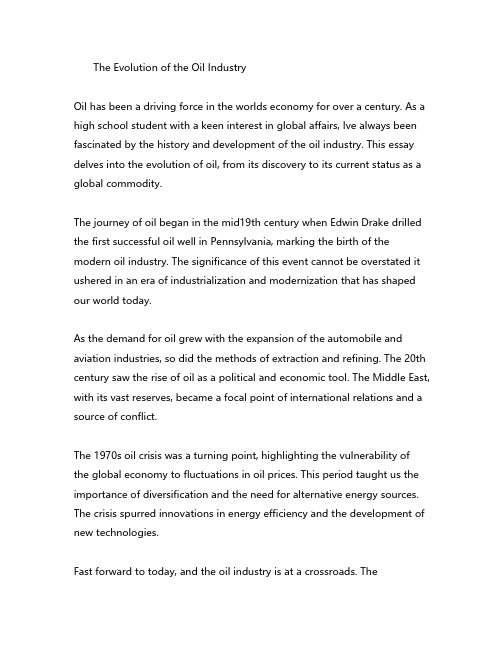
The Evolution of the Oil IndustryOil has been a driving force in the worlds economy for over a century. As a high school student with a keen interest in global affairs, Ive always been fascinated by the history and development of the oil industry. This essay delves into the evolution of oil, from its discovery to its current status as a global commodity.The journey of oil began in the mid19th century when Edwin Drake drilled the first successful oil well in Pennsylvania, marking the birth of the modern oil industry. The significance of this event cannot be overstated it ushered in an era of industrialization and modernization that has shaped our world today.As the demand for oil grew with the expansion of the automobile and aviation industries, so did the methods of extraction and refining. The 20th century saw the rise of oil as a political and economic tool. The Middle East, with its vast reserves, became a focal point of international relations and a source of conflict.The 1970s oil crisis was a turning point, highlighting the vulnerability of the global economy to fluctuations in oil prices. This period taught us the importance of diversification and the need for alternative energy sources. The crisis spurred innovations in energy efficiency and the development of new technologies.Fast forward to today, and the oil industry is at a crossroads. Theenvironmental impact of oil extraction and consumption has become a pressing concern. The Paris Agreement and the global push for renewable energy signal a shift away from fossil fuels. Yet, oil remains indispensable for many industries and is still a major player in the global economy.The future of the oil industry is uncertain but exciting. Advances in technology such as hydraulic fracturing, or fracking, have unlocked new reserves and extended the life of oil as an energy source. At the same time, the rise of electric vehicles and renewable energy sources like solar and wind power are challenging the dominance of oil.In conclusion, the oil industry has come a long way since the days of Edwin Drake. It has been a catalyst for global development but also a source of conflict and environmental concern. As we stand on the brink of a new era of energy, the evolution of the oil industry will continue to be a critical factor in shaping our world.石油工业的发展石油在世界经济中已是一个驱动力超过一个世纪。
简单的石油英语翻译
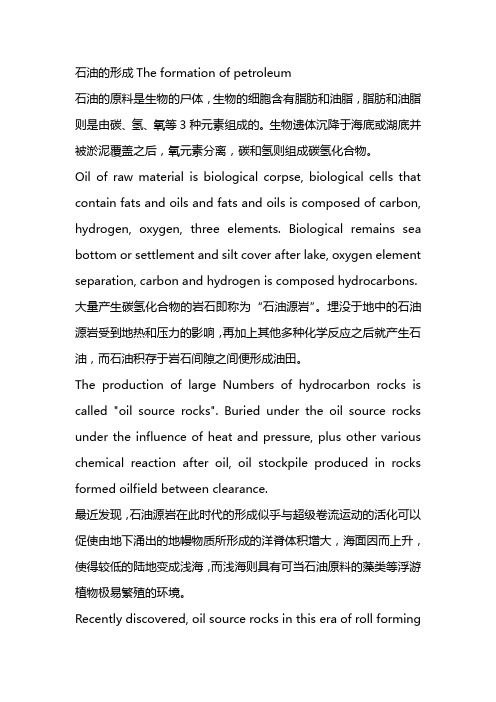
石油的形成The formation of petroleum石油的原料是生物的尸体,生物的细胞含有脂肪和油脂,脂肪和油脂则是由碳、氢、氧等3种元素组成的。
生物遗体沉降于海底或湖底并被淤泥覆盖之后,氧元素分离,碳和氢则组成碳氢化合物。
Oil of raw material is biological corpse, biological cells that contain fats and oils and fats and oils is composed of carbon, hydrogen, oxygen, three elements. Biological remains sea bottom or settlement and silt cover after lake, oxygen element separation, carbon and hydrogen is composed hydrocarbons.大量产生碳氢化合物的岩石即称为“石油源岩”。
埋没于地中的石油源岩受到地热和压力的影响,再加上其他多种化学反应之后就产生石油,而石油积存于岩石间隙之间便形成油田。
The production of large Numbers of hydrocarbon rocks is called "oil source rocks". Buried under the oil source rocks under the influence of heat and pressure, plus other various chemical reaction after oil, oil stockpile produced in rocks formed oilfield between clearance.最近发现,石油源岩在此时代的形成似乎与超级卷流运动的活化可以促使由地下涌出的地幔物质所形成的洋脊体积增大,海面因而上升,使得较低的陆地变成浅海,而浅海则具有可当石油原料的藻类等浮游植物极易繁殖的环境。
石油英语翻译实践内容
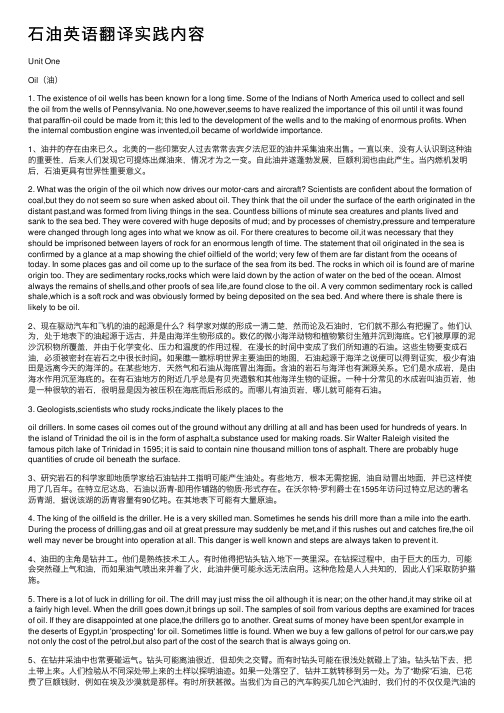
⽯油英语翻译实践内容Unit OneOil(油)1. The existence of oil wells has been known for a long time. Some of the Indians of North America used to collect and sell the oil from the wells of Pennsylvania. No one,however,seems to have realized the importance of this oil until it was found that paraffin-oil could be made from it; this led to the development of the wells and to the making of enormous profits. When the internal combustion engine was invented,oil became of worldwide importance.1、油井的存在由来已久。
北美的⼀些印第安⼈过去常常去宾⼣法尼亚的油井采集油来出售。
⼀直以来,没有⼈认识到这种油的重要性,后来⼈们发现它可提炼出煤油来,情况才为之⼀变。
⾃此油井遂蓬勃发展,巨额利润也由此产⽣。
当内燃机发明后,⽯油更具有世界性重要意义。
2. What was the origin of the oil which now drives our motor-cars and aircraft? Scientists are confident about the formation of coal,but they do not seem so sure when asked about oil. They think that the oil under the surface of the earth originated in the distant past,and was formed from living things in the sea. Countless billions of minute sea creatures and plants lived and sank to the sea bed. They were covered with huge deposits of mud; and by processes of chemistry,pressure and temperature were changed through long ages into what we know as oil. For there creatures to become oil,it was necessary that they should be imprisoned between layers of rock for an enormous length of time. The statement that oil originated in the sea is confirmed by a glance at a map showing the chief oilfield of the world; very few of them are far distant from the oceans of today. In some places gas and oil come up to the surface of the sea from its bed. The rocks in which oil is found are of marine origin too. They are sedimentary rocks,rocks which were laid down by the action of water on the bed of the ocean. Almost always the remains of shells,and other proofs of sea life,are found close to the oil. A very common sedimentary rock is called shale,which is a soft rock and was obviously formed by being deposited on the sea bed. And where there is shale there is likely to be oil.2、现在驱动汽车和飞机的油的起源是什么?科学家对煤的形成⼀清⼆楚,然⽽论及⽯油时,它们就不那么有把握了。
- 1、下载文档前请自行甄别文档内容的完整性,平台不提供额外的编辑、内容补充、找答案等附加服务。
- 2、"仅部分预览"的文档,不可在线预览部分如存在完整性等问题,可反馈申请退款(可完整预览的文档不适用该条件!)。
- 3、如文档侵犯您的权益,请联系客服反馈,我们会尽快为您处理(人工客服工作时间:9:00-18:30)。
Unit OneOil(油)1. The existence of oil wells has been known for a long time. Some of the Indians of North America used to collect and sell the oil from the wells of Pennsylvania. No one,however,seems to have realized the importance of this oil until it was found that paraffin-oil could be made from it; this led to the development of the wells and to the making of enormous profits. When the internal combustion engine was invented,oil became of worldwide importance.1、油井的存在由来已久。
北美的一些印第安人过去常常去宾夕法尼亚的油井采集油来出售。
一直以来,没有人认识到这种油的重要性,后来人们发现它可提炼出煤油来,情况才为之一变。
自此油井遂蓬勃发展,巨额利润也由此产生。
当内燃机发明后,石油更具有世界性重要意义。
2. What was the origin of the oil which now drives our motor-cars and aircraft? Scientists are confident about the formation of coal,but they do not seem so sure when asked about oil. They think that the oil under the surface of the earth originated in the distant past,and was formed from living things in the sea. Countless billions of minute sea creatures and plants lived and sank to the sea bed. They were covered with huge deposits of mud; and by processes of chemistry,pressure and temperature were changed through long ages into what we know as oil. For there creatures to become oil,it was necessary that they should be imprisoned between layers of rock for an enormous length of time. The statement that oil originated in the sea is confirmed by a glance at a map showing the chief oilfield of the world; very few of them are far distant from the oceans of today. In some places gas and oil come up to the surface of the sea from its bed. The rocks in which oil is found are of marine origin too. They are sedimentary rocks,rocks which were laid down by the action of water on the bed of the ocean. Almost always the remains of shells,and other proofs of sea life,are found close to the oil. A very common sedimentary rock is called shale,which is a soft rock and was obviously formed by being deposited on the sea bed. And where there is shale there is likely to be oil.2、现在驱动汽车和飞机的油的起源是什么?科学家对煤的形成一清二楚,然而论及石油时,它们就不那么有把握了。
他们认为,处于地表下的油起源于远古,并是由海洋生物形成的。
数亿的微小海洋动物和植物繁衍生殖并沉到海底。
它们被厚厚的泥沙沉积物所覆盖,并由于化学变化、压力和温度的作用过程,在漫长的时间中变成了我们所知道的石油。
这些生物要变成石油,必须被密封在岩石之中很长时间。
如果瞧一瞧标明世界主要油田的地图,石油起源于海洋之说便可以得到证实,极少有油田是远离今天的海洋的。
在某些地方,天然气和石油从海底冒出海面。
含油的岩石与海洋也有渊源关系。
它们是水成岩,是由海水作用沉至海底的。
在有石油地方的附近几乎总是有贝壳遗骸和其他海洋生物的证据。
一种十分常见的水成岩叫油页岩,他是一种很软的岩石,很明显是因为被压积在海底而后形成的。
而哪儿有油页岩,哪儿就可能有石油。
3. Geologists,scientists who study rocks,indicate the likely places to theoil drillers. In some cases oil comes out of the ground without any drilling at all and has been used for hundreds of years. In the island of Trinidad the oil is in the form of asphalt,a substance used for making roads. Sir Walter Raleigh visited the famous pitch lake of Trinidad in 1595; it is said to contain nine thousand million tons of asphalt. There are probably huge quantities of crude oil beneath the surface.3、研究岩石的科学家即地质学家给石油钻井工指明可能产生油处。
有些地方,根本无需挖掘,油自动冒出地面,并已这样使用了几百年。
在特立尼达岛,石油以沥青-即用作铺路的物质-形式存在。
在沃尔特·罗利爵士在1595年访问过特立尼达的著名沥青湖,据说该湖的沥青容量有90亿吨。
在其地表下可能有大量原油。
4. The king of the oilfield is the driller. He is a very skilled man. Sometimes he sends his drill more than a mile into the earth. During the process of drilling,gas and oil at great pressure may suddenly be met,and if this rushes out and catches fire,the oil well may never be brought into operation at all. This danger is well known and steps are always taken to prevent it.4、油田的主角是钻井工。
他们是熟练技术工人。
有时他得把钻头钻入地下一英里深。
在钻探过程中,由于巨大的压力,可能会突然碰上气和油,而如果油气喷出来并着了火,此油井便可能永远无法启用。
这种危险是人人共知的,因此人们采取防护措施。
5. There is a lot of luck in drilling for oil. The drill may just miss the oil although it is near; on the other hand,it may strike oil at a fairly high level. When the drill goes down,it brings up soil. The samples of soil from various depths are examined for traces of oil. If they are disappointed at one place,the drillers go to another. Great sums of money have been spent,for example in the deserts of Egypt,in 'prospecting' for oil. Sometimes little is found. When we buy a few gallons of petrol for our cars,we pay not only the cost of the petrol,but also part of the cost of the search that is always going on.5、在钻井采油中也常要碰运气。
钻头可能离油很近,但却失之交臂。
而有时钻头可能在很浅处就碰上了油。
钻头钻下去,把土带上来。
人们检验从不同深处带上来的土样以探明油迹。
如果一处落空了,钻井工就转移到另一处。
为了“勘探”石油,已花费了巨额钱财,例如在埃及沙漠就是那样。
有时所获甚微。
当我们为自己的汽车购买几加仑汽油时,我们付的不仅仅是汽油的价钱,而且还包括了一部分不断在进行着的勘探费用。
6. When the crude oil is obtained from the field,it is taken to the refineries to be treated. The commonest form of treatment is heating. When the oil is heated,the first vapors to rise are cooled and become the finest petrol. Petrol has a low boiling point; if a little is poured into the hand,it soon vaporizes. Gas that comes off the oil later is condensed into paraffin. Last of all the lubricating oils of various grades are produced. What remains is heavy oil that is used as fuel.6、当原油从油田取得后,就被送往炼油厂去处理。
